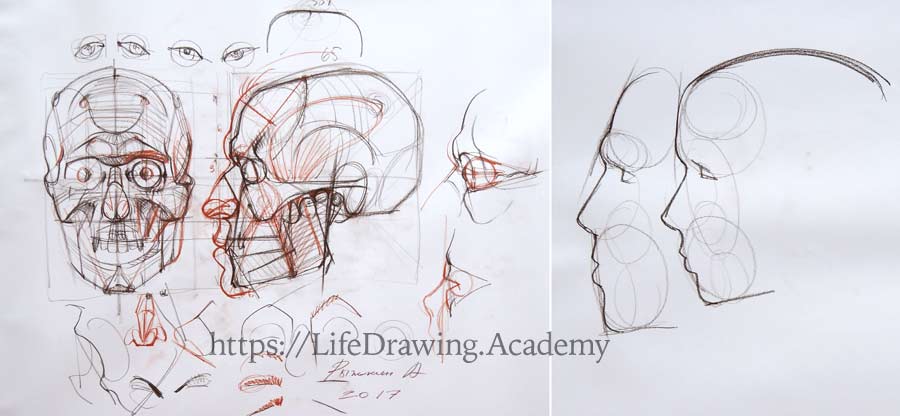How to Draw a Head
This is your unique chance to get unlimited personal tutoring at a tiny fraction of what it really costs.
Don't miss your once-in-a-lifetime opportunity
Enroll in the Life Drawing Academy now!
How to Draw a Head
By Alexander Ryzhkin
In this video lesson, we will talk about How to Draw a Head.

Let's talk about alignments. We've already established that the base of the nose is on the same level as an ear and the base of the skull. If we take a virtual line that goes through the corner of an eye and the nose wing, it is usually parallel to the vertical edge of the lower jaw, which has the same tilt as the line where an ear connects to the skull. These two lines are good to check when drawing portraits in the side view.
Now, let's examine the construction of an eye. In the side view cross-section, the eye socket resembles a pyramid that points into a skull. An eye is essentially a ball about one inch in diameter that is located inside the eye socket. The eyeball does not protrude beyond a virtual line of eye socket edges. Inside an eye socket, there are muscles that move the eye. They can rotate an eye from side to side and up and down as well as squeeze it to change the focal length. From the eyeball, the optic nerve goes to the brain through the hole at the bottom of the eye socket. These eye socket holes are crescent-shaped. Although you don't have to mark the full ball of an eye when drawing portraits, understanding of how and where it sits inside eye sockets will help you position eyes with precision in life drawing. At the inner corner of the eye is the smallest bone of the skull. The eye's lateral corner coincides with the small bony projection on that side of the eye socket. The corners of the eyes are usually on the same level, but sometimes one corner can be a bit higher or lower than the other. In such cases, the axes of the eyes will have slightly ascending or descending angles. The angle of eyelids, however, does not influence the position of the eyeball itself. Often, the irises of the eyes are located slightly wider than holes at the bottom of the eye sockets. So, the distance between the pupils will be slightly bigger than the distance between the two frontal eminences of the forehead because those eminences are usually vertically aligned with the holes.You need to remember that there are no two identical human skulls in the world. Every person has individual recognizable features, and we are talking here about general proportions and alignments rather absolute rules. Shapes and proportions of skulls vary not only from male to female, but also people from different continents have some divergences in shapes, and the shapes change with aging as well. For example, some people may have eye sockets with a different shape, so the eyeball doesn't sit as deeply inside as in other cases. This makes the eyelids more protruding, and sometimes they can be on the same level as the bridge of the nose. All those individual features have to be observed on a model and depicted in drawing to portray a person's likeness. There are also some differences in male and female skulls. In general, female skulls have slightly more prominent foreheads and a bit less developed lower jaws than male skulls. Male skulls usually have bigger lower jaws. Of course, there are exceptions.
The angle of the forehead in male skulls is usually a bit more sloped, and in female skulls it is more straight. Male skulls have more prominent brow ridges than female. Once again, this is not a rule but general tendency. Noses are very individual facial features, and there is no big difference between male and female noses. Because male skulls tend to have bigger brow ridges, the eyes might appear a bit deeper beneath ridges. In male skulls, the jaws are more developed and, in general, a bit bigger than in female skulls. So, when you draw a portrait from life, you have to pay attention to such differences in shapes and volumes and use your knowledge of proportions to see those discrepancies from model to model. Also, when measuring the third-of-the-face proportion, you need to be aware that the hairline can also vary greatly from person to person.
There is one hint where this line is. If we take a virtual line between the nose bridge and the top end of the frontal bone, divide this line in half and draw a perpendicular line from that point, this line will cross the outline of the forehead at the hairline. Of course, this is not an absolute rule. The actual line of hair roots can be higher or lower and change its location with age...
[ The full lesson is avaibale to Life Drawing Academy members ]
This is your unique chance to get a lifetime academy membership and a dedicated team of art teachers.
Such unlimited personal tutoring is not available anywhere else.




